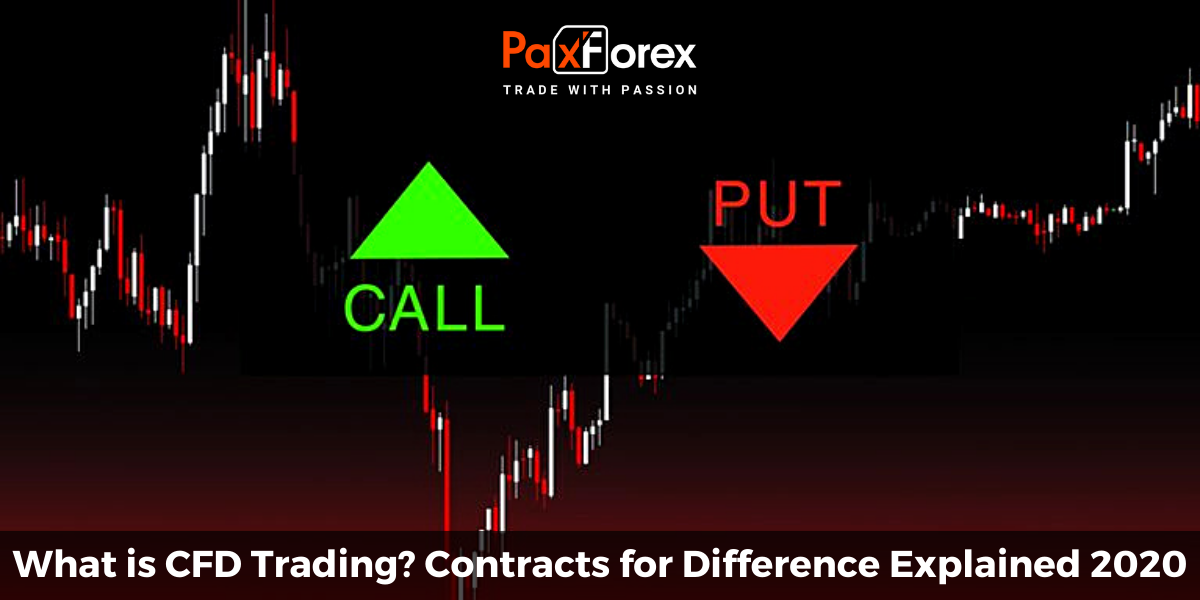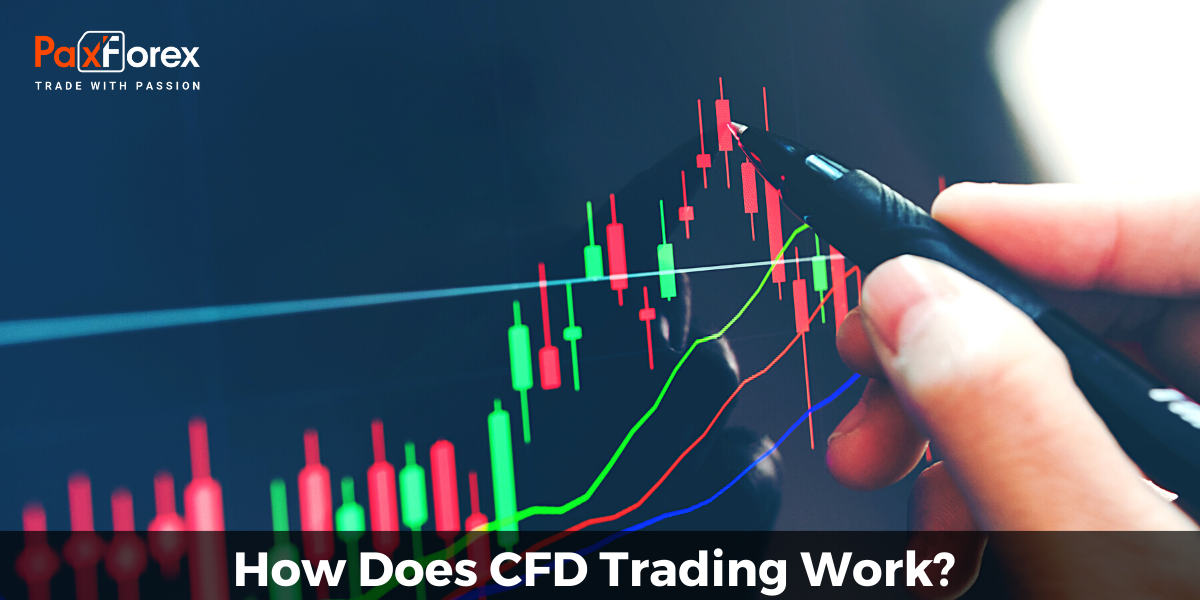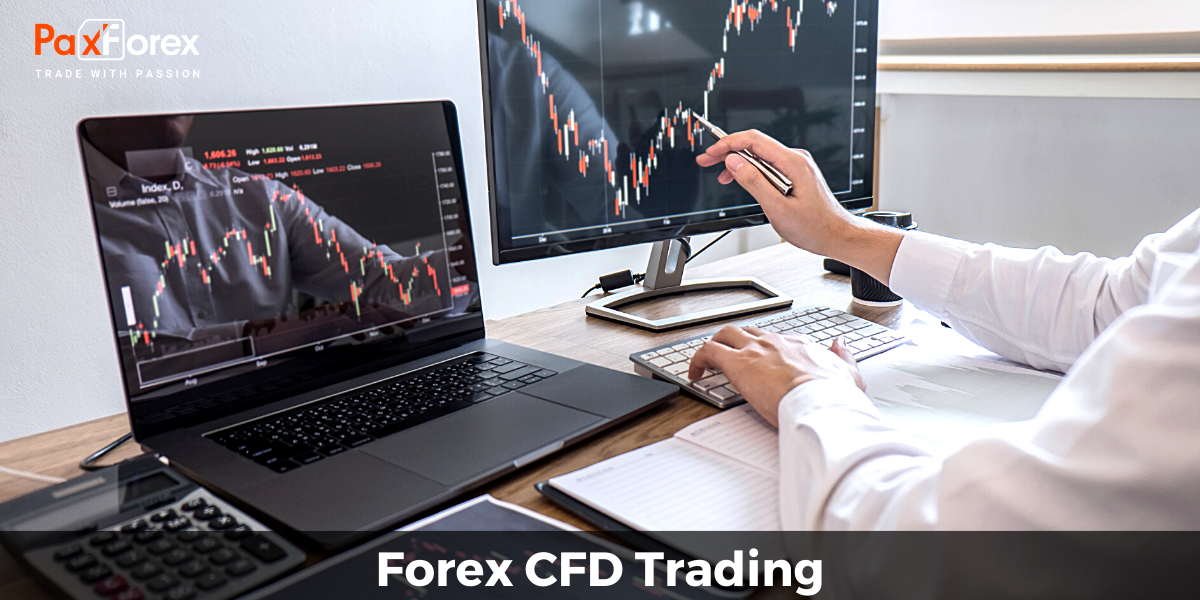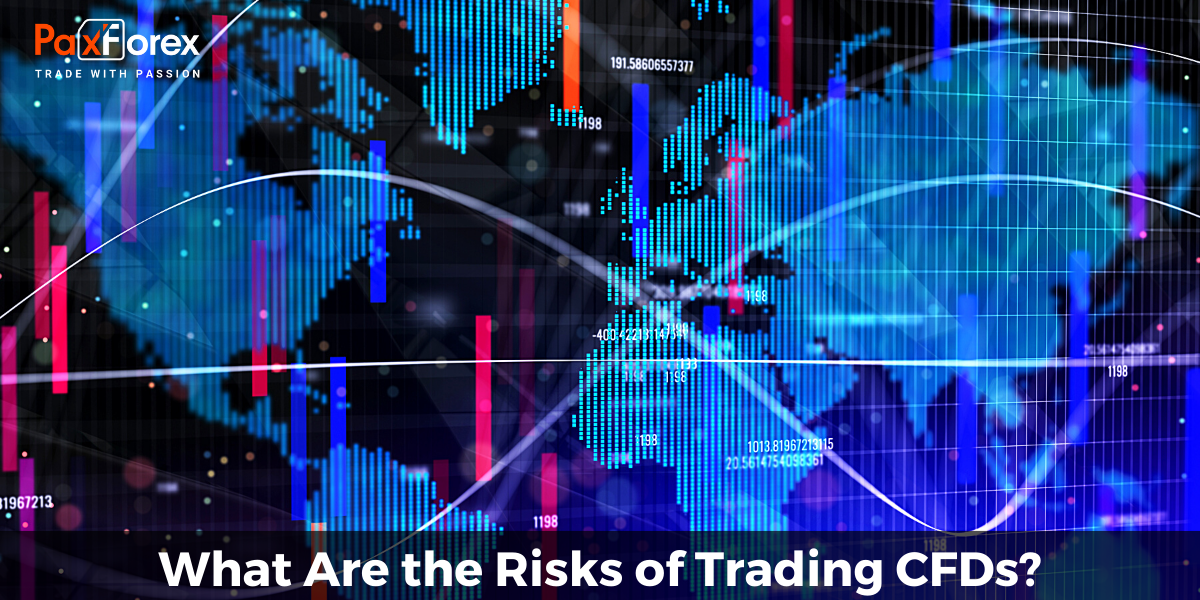
Many traders are not limited to trading in currency pairs, some of them are actively trading CFD contracts. This is an effective and convenient speculative mechanism for exchange trading in stocks, indices, futures, and commodities. CFD contracts on exchange assets are characterized by high volatility (if compared to currency) and a long duration of price trend, which allows traders to get a high income.
What are CFDs?
CFD is a derivative contract, where a percentage of the value is taken from stock (or any other asset called "base") equal to 1 lot. Unlike a futures contract, a lot can be split like a currency one to a minimum of 0.01 lot.
Such pricing is an explanation for the origin of a contract. Securities of U.S. or European companies are traded at a cost of tens to hundreds of dollars. The prices of futures and options reach the value of a used car. A small investor has only one option - to buy one share at 5% of its value.
CFD is an over-the-counter offer between a broker and a trader, where the price of buying or selling an asset (from the broker's list) is taken as zero. The trader, who concluded the contract, makes a deposit (2 or 5% of the market value of the asset), knowing that at the closing of the position he will either make a profit if the trading result is positive or a loss will be written off the account.
Similarities between CFD and Forex
Both CFD and Forex trading avoid the transfer of physical assets. They both trade on the Over-the-Counter (OTC) principle, which means that their operations are decentralized and carried out through a network of financial institutions. Their operations are also usually carried out similarly. Besides, they trade through the same platforms, which has led some service providers to offer platforms that traders can use for both CFD and Forex.
As for leverage, CFDs and Forex offer access to margin. The margin that investors can use when trading CFDs is usually specified as a fixed percentage. For example, if the margin is 10%, it means that a trader can set aside 10% of the total market value of the contract and take the balance.
Alternatively, the margin used in Forex trading is usually a ratio such as 1:5 or 1:10. For example, if a trader has a leverage ratio of 1:5, he may trade $5 for every $1 in his account. Another similarity between CFD and Forex is that their trading costs are at least partly based on the spread.
How does CFD trading work?

CFDs are extremely popular on the London Stock Exchange, where their use in risk hedging is a significant part of the volume on the exchange. Brokers offer CFD products in markets around the world, making them highly available and traders can use CFDs for multiple assets.
CFDs can include assets such as: cryptocurrencies, indices, Forex, commodities, futures, and stocks
CFDs are negotiated between two counterparties, the investor and the broker. The contract provides for the payment of one party to the other based on the difference in price movements of the underlying asset from entry to exit.
It is noteworthy that there is no expiration date for the contract, as in the case of ordinary futures contracts, and the participants do not own the underlying asset. Rather, they speculate only on price movements and the contract may remain open - moving on to trading the next day - as long as the margin value in the investor's account can support the contract.
Investors can withdraw from their contract with a broker without paying commissions because the broker earns income by requiring the investor to pay the spread - the contract trade shows a loss equal to the spread when the investor enters the trade.
When buying, the trader pays the ask price, and when selling, the sale is made at the offer price.
Similar to futures contracts, investors can take a long or short position with CFD on the price movement of the asset.
To better understand the basics, let's take a look at an example:
Let's assume that the trader has deposited $2,000 in his account. He decided to buy a CFD on "Any company" shares of 8 lots (80 shares for $25 each).
Five days later, the value of "Any company" shares rose to $26 per share, and the trader sold the contract. He received $2,800. Out of this money, he has to pay his broker 40 dollars to transfer positions (0.5 USD x 8 lots x 5 days). This way, he made $760. You should read the trading conditions of brokers carefully, as the commission may differ.
What are the benefits of trading CFDs?
In general, CFDs are widely available for a variety of financial assets and have unique advantages based on their differences from the futures and options markets. In particular, trading CFDs is cheaper than trading real assets, provides higher leverage, has global access, and is not subject to purchase restrictions.
Trading CFDs is cheaper than trading real assets for several reasons:
First, investors save 0.5% on transaction costs because they do not own the underlying asset, they are not subject to stamp duty on the purchase.
Secondly, investors do not pay the commission because they enter into a CFD contract at the "Ask" price (demand) and the broker receives income through the spread - fixed spreads are usually also available.
Thirdly, professional trading on stock exchanges can be paid - this is not the case with CFDs.
Finally, investors can easily enter the CFD market by opening a margin account for future trading through a broker.
One of the main advantages of CFDs is the low level of margin requirements. Sometimes an income of up to 3% allows retail investors to make more substantial profits with fewer advance payments.
However, this leverage carries higher risks if the contract becomes bad for the investor and can expose them to significant losses, which has become the subject of a dispute among regulators with CFD.
The global availability of CFDs is also an important advantage. Investors can access everything from stocks to commodities through price speculation, while CFDs are a trivial way for less experienced investors to enter the market.
Access to many international markets is difficult, and traders can speculate on the price movements of different assets on the same platform through a broker.
Finally, CFDs are not subject to short-circuit rules in specific markets, such as requirements to borrow the underlying asset and additional brokerage fees associated with short call trades.
One of the main areas in which large investors use CFDs is risk hedging in volatile markets, as well as portfolio diversification - convenience due to their rapid availability and assets covered.
CFD leverage
Perhaps the biggest advantage of CFD trading is the possibility of margin trading, i.e. leveraged trading where you can manage a large and potentially profitable position using only a small deposit. In this case, insignificant funds serve as leverage and guarantee under the credit issued by the broker, which allows you to multiply the potential profit from trades.
In case of margin trading you are provided with the following advantages:
Possibility to open positions and enter the market with relatively small capital
Opportunity to significantly increase income by using only small amounts of investment
However, learning how to CFD trade you`ll find out that not all positions will be profitable. Carrying out margin trading, you also increase your risks, because along with multiple increases in your potential profit, the risk of losses in the ray of unsuccessful positions increases, up to the possibility of complete loss of invested funds.
Let`s have a look at the example of leveraged CFD: You open a $10,000 position with a 10% deposit which gives you 10:1 leverage on your capital. Theoretically, you can make ten times the profit you would have without using leverage, but equally, the risk of loss increases. Using different risk management methods, you can limit your losses.
Trade long and short
СFD is a flexible investment instrument. If you are confident in a growing market, you can generate income by opening a position to buy a CFD. You can also speculate on falling prices by selling CFDs. Holders of open positions to buy CFDs on shares will receive a dividend adjustment equal to the amount of the declared dividend payable if at the time of opening of trading on the date of the adjustment (coinciding with the ex-dividend date) a long position is opened for the instrument. Conversely, the dividend adjustment is withheld from the client's account if a CFD Sell position is opened.
Wide range of CFD markets
OTC assets, to which CFDs relate, are written out for a wide range of markets, including stocks, indices, commodities, and so on.
As a rule, CFDs on stocks of well-known brands are in demand. Quotations and tickers of instruments coincide in trading terminals of Forex brokers and exchanges where these securities are traded during IPO.
Each exchange has its index, which includes securities of the "flagships" of the country's economy ("blue chips"), calculated by the method of the platform. Buying or selling an index is possible through CFD contracts. The index value is relative and is measured in the process of constant stock exchange recalculation. Therefore, the underlying asset that determines the value and calculation of the difference for a CFD is an index futures.
Energy futures, as well as bonds and currency, can be purchased as CFD contracts. The supply width of the type of underlying instruments, which determine contracts for difference, is limited by the offers of world exchanges and the broker's imagination.
Forex CFD Trading

In addition to the spot market, you can also trade CFD on currency pairs. Notably, the huge volume of currency trading that occurs in one day can make currency markets extremely volatile - and it is the volatility that makes currency trading attractive.
There is a wide range of currency pairs available, including the most popular EUR/USD, USD/JPY, and GBP/USD. Apart from major currency pairs, there are also minor and exotic ones. Pay attention that exotic pairs have high spread, they are low-liquid and have weakly predicted movements.
CFD Indices
There are also CFD contracts on exchange indices in the market. They practically do not differ from contracts for difference in shares. However, this type of contract is a rather specific financial instrument of a trader. A trader can make a profit depending on changes in the numerical values of exchange indices.
Any exchange index can act as a base asset. Its every point is equated to a certain numerical value (sum). For example, let one point of the NASDAQ index be 0.01, then its lot will be equated to the double value of the instrument itself and will be valued at $0.02. The same rule applies to currency accounts. It is important to keep in mind that the stock index can change its value by several thousand pips per trading session. Thus, with the right approach, a trader can earn good money by opening CFD contracts on exchange indices. But there is also the reverse side of the coin, with the wrong analysis the losses will be tangible.
The movement of exchange indices in one direction or another depends on the movement of many financial instruments (shares, currencies), included in the calculation of the exchange index. Therefore, knowing how the price of a certain exchange index is formed, one can always diversify his risks.
Commodity CFDs
CFDs are considered an effective way to trade popular commodities – such as Oil, Natural Gas, Gold, or Silver – because of higher leverage, which allows a trader to have fewer funds to get greater exposure to an underlying asset.
Share CFDs
CFDs on shares is a convenient tool that allows traders to profit from changes in the price of shares of large American or European companies, for example, Amazon, Microsoft, Disney, etc. An important feature and advantage of such contracts are that the trader does not receive shares in the ownership, so he does not need to meet the requirements of a qualified investor and have a large deposit.
The key disadvantage of CFDs is the absence of dividends and relatively high spreads. However, this becomes insignificant against the background of the possibility to become a stock market participant and profit from the growth of world-famous organizations.
CFDs on cryptocurrencies
Cryptocurrencies are virtual currencies that typically use a decentralized network to conduct secure financial transactions. With the PaxForex trading platform, you can trade CFDs on cryptocurrencies such as Bitcoin, Ripple, Ethereum, and others, speculating on their price movements without actually owning them.
What are the benefits of cryptocurrencies CFDs?
There is no need to have a currency account or use an electronic wallet;
Trading in any direction - selling is just as accessible as buying;
Round-the-clock availability - 7 days a week, 24 hours a day;
The profit potential on the bullish and bearish markets.
CFD trading hours
Once you decide to add CFD in trading, you have to take into account the trading hours so you can make the most out of your trading.
To start with, here are CFD trading times of popular CFDs;
- Forex CFDs: trading 24/5
- Index CFDs: trading 24/5
Share CFDs: just like the stock exchange it refers to
- Commodity CFDs: trading 24/5
- Cryptocurrency CFDs: trading 24/7
Considering the whole week, you can trade CFD on Forex, commodities, and indices from 10 pm on Sunday until 9 pm GMT on Friday.
Do not forget that the most volatile hours occur when several markets are open at the same time, so to say, intersect. One more aspect to consider is a trading session since each of them predetermines the activity of an underlying asset.
There are 4 trading sessions:
- Asian - 11.00 pm GMT - 07.00 am GMT
- European (London) - 07.00 am GMT - 03.00 pm GMT
- American - 12.00 pm GMT - 08.00 pm GMT
- Pacific - 10.00 pm GMT - 06.00 am GMT
Costs of trading
Now let`s talk about the costs of CFD trading. The number one thing we should mention is that the trading costs differ tremendously, depending on many factors: brokers, markets, and assets.
Some brokers do not charge clients for day trading at all, making money only on the spread (the difference between the Bid and Ask prices of the underlying asset).
- Fees and spread
Probably, the first cost coming to mind is a commission or fee on the price of the traded asset. This commission may vary enormously, from 0.1% to possibly 0.5%, or higher. Luckily, this is a very competitive market, so the ability of brokers to charge abrupt fees is seriously bound.
In case a fee is applicable, it will normally refer to all assets, counting indices.
Another way to pay your brokerage company is by the spread, as we have mentioned before. This difference between buying and selling prices suggests that a trader’s trade needs to pass several points in "trader`s direction" prior to they could even sell the contract back for the price paid.
- Overnight charges
If you are charged by your broker both, commission and spread, you should have due regard for both since the whole trading will be predefined by these costs. Also, note the low fee may cover wide spreads and the other way round. The entire cost is the major sum.
The overnight commission will be charged or credited if the trade is left open overnight. The amount depends on the direction of the trade and the relevant holding rate.
What are the risks of trading CFDs?

Before you start trading CFDs, it is important that you understand all the risks involved and how to manage them effectively.
- Leverage
One of the main risks of CFD trading comes from the advantage of trading with leverage, which allows traders to open positions with volumes many times larger than their funds. With a competent approach to leverage, profit from trading can be increased in proportion to the amount of borrowed funds used (leverage).
However, the same is true for possible losses if the market moves against you. Losses incurred when using leverage will also be disproportionate to the amount of leverage used. If only 5% of your deposit is required, but the market moves against you by 10%, you will lose twice the amount of your investment. This trading risk associated with CFDs is the most common and can affect trading on any of the world markets, regardless of the underlying assets.
- The volatility of the market
Due to the volatility in the traded markets, there are many trading opportunities for traders, but this, in turn, can also carry a high level of risk. This is especially true for gap opening (opening and closing prices of trading sessions that occur during non-working hours - weekends, holidays, night time, etc.). when traders are unable to influence the open position in any way. In some cases, accounts and positions may close if they fall below the closing level.
Some volatility can be predicted in the run-up to the upcoming political elections or before the publication of financial reports of large corporations and macroeconomic statistics, etc. Other circumstances, such as natural and man-made disasters, etc. are less predictable and also carry a high level of risk of CFD trading on currency, commodity, and stock markets. In some cases, high volatility may contribute to the movement of markets in your favor - in the direction of your open positions, and in other cases - not.
- Risk management
Effective management of trading risks associated with CFDs is essential to the success of any trading strategy. There are several easy ways to deal with risks:
Use margin prudently and with the utmost care so that you have sufficient funds to cover any losses.
Set a Stop Loss, which will close positions when the price reaches a certain level to reduce losses.
Hedge against any other investments by opening a short position against the assets underlying your portfolio to reduce the risk of short-term losses.
- The risks associated with trading CFDs are outweighed by the benefits and potential for high returns, but this, in turn, implies their proper valuation and an accurate understanding of how they are managed.
If you are new to CFD trading, we recommend that you start by opening a demo account to learn and gain relevant experience, which will help you to better manage your risks when trading with real money.
Who can trade CFDs?
Almost anyone can use CFD in trading as long as the basic principles of risk management are respected.
CFD is perfect for beginner traders who want to try their hand at trading and take advantage of a large number of financial markets, and looking for something to invest in but don’t have sufficient funds. On the other hand, trading in CFD will be perfect for seasoned investors seeking diversification and more flexibility
Choosing a CFD Broker and CFD trading platform
CFD is a modern and attractive financial instrument for those interested in speculative trading. CFD brokers, in their turn, act as intermediaries between market and trader. Their task is to provide the best analytical tools and favorable trading conditions. Consequently, the choice of the broker should be taken as seriously as possible. When choosing a CFD-broker, pay attention to such aspects:
- having a free demo account;
- initial deposit amount;
- possibilities and conditions of real accounts;
- the quality of the analytical section and the proposed tools for setting up charts;
- reliability and relevance of quotations;
- terms and conditions of CFD contracts for different types of assets;
- brokerage commission for trades;
- trading hours and terms of transfer of trades to the next trading session;
- the reputation of the firm among traders;
- methods of protection of personal information and traders' funds used by the broker;
PaxForex is a user-friendly online trading platform for CFD markets providing clients straightforward and comfortable access to various markets including Forex, commodities, shares, and cryptocurrencies. Left alone competitive spreads from 0,4 pips with up to 500 times the leverage.
With PaxForex you will be able to trade CFD on:
Forex: EUR/USD, GBP/USD, USD/CAD, AUD/USD, USD/JPY and others
Indices: DAX30/ UK100/ NQ100/ ASX200 and others.
Commodities: Silver and Gold.
Cryptocurrencies: Bitcoin, Ethereum, Litecoin, and Ripple.
Conclusion
Among the speculative tools that have a high degree of efficiency when working with index, commodity futures, and shares, CFD is favorably characterized by the convenience of use and is increasingly becoming the preferred investment option for modern traders. They allow you to gain complete independence and create a personal portfolio that fits your budget and financial goals.
On the objective side, profit from CFD trading is very lucrative, and once taken seriously, the reward is ensured. The main thing is not to be lazy to seriously learn how to CFD trade and make long-term forecasts.







